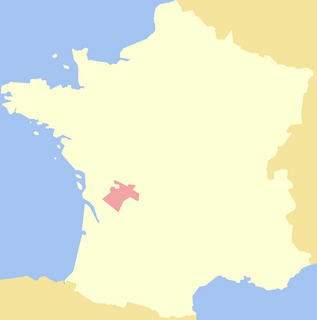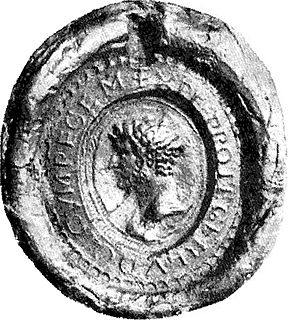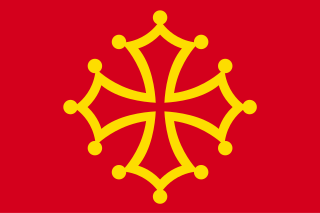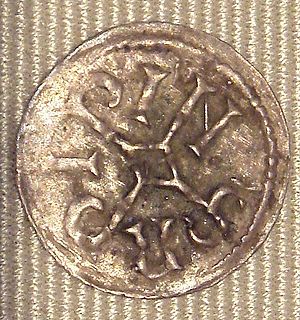Ebroin (died 850×54) was bishop of Poitiers from 839 to his death. He took on the administration of the county of Poitiers during a troubled period and continued to faithfully support King Charles the Bald.

Charles the Bald was the King of West Francia (843–877), King of Italy (875–877) and Holy Roman Emperor. After a series of civil wars during the reign of his father, Louis the Pious, Charles succeeded by the Treaty of Verdun (843) in acquiring the western third of the Carolingian Empire. He was a grandson of Charlemagne and the youngest son of Louis the Pious by his second wife, Judith.
Contents
In 835 Ebroin's cousin, Count Rorig I of Maine, petitioned King Pippin I for the monastery of Glanfeuil to be given to Ebroin. [1] Glanfeuil had been placed under the authority of another relative of Ebroin's, Abbot Ingelbert of Saint-Pierre-des-Fossés, by the Emperor Louis the Pious in 833. [2] In 844 Ebroin bestowed the office of abbot on Rorig's son Gauslin. [1] On 14 July 847 Charles confirmed Ebroin's right of possession (ius [et] dominatio) of abbey, apparently without oversight from Fossés, and its heritability in his family. [2]

Rorgon I or Rorico(n) I was the first Count of Maine and progenitor of the Rorgonid dynasty, which is named for him. He was Count of Rennes from 819 and of Maine from 832 until his death.

Saint-Maur-des-Fossés is a commune in the southeastern suburbs of Paris, France. It is located 11.7 kilometres from the center of Paris.

Louis the Pious, also called the Fair, and the Debonaire, was the King of the Franks and co-Emperor with his father, Charlemagne, from 813. He was also King of Aquitaine from 781.
In 839 Ebroin sided with Charles the Bald against Pippin II in the battle for the subkingdom of Aquitaine, which had been ruled by Pippin I, Charles' brother and Pippin's father, until his death in 838. According to the Vita Hludovici , Ebroin was Charles's advisor on Aquitainian affairs. [3] Between Charles's first visit to Poitiers in April 839 and February 840, when the emperor left him in charge of conducting a campaign against Pippin II, Charles appointed Ebroin as his archchaplain. [4]

Vita Hludovici or Vita Hludovici Imperatoris is an anonymous biography of Louis the Pious, Holy Roman Emperor and King of the Franks from AD 814 to 840.
An Archchaplain is a cleric with a senior position in a royal court. The title was used in the Frankish kingdom in the Carolingian period.
Ebroin was among the leaders of the army being assembled to fight Pippin in northern Aquitaine 844. On 14 June 844, while on the march south to meet Charles in the south, the army was ambushed by Pippin's forces in the Angoumois. The king's uncle, Abbot Hugh, was killed, and Ebroin, along with Bishop Ragenar of Amiens and Abbot Lupus of Ferrières, was captured. [5] Ebroin had been freed by December 844, when he attended the council of Ver. [6] He helped negotiate the settlement of June 845, in which most of Aquitaine was ceded to Pippin in vassalage to Charles. [7]

Angoumois or equally historically the comté d'Angoulême was a county and province of France, originally inferior to the parent duchy of Aquitaine, similar to the Périgord to its east but lower and generally less forested, equally with occasional vineyards throughout. Its capital was Angoulême with its citadel and castle above the River Charente.
Hugh (802–844) was the illegitimate son of Charlemagne and his concubine Regina, with whom he had one other son: Bishop Drogo of Metz (801–855). Along with Drogo and his illegitimate half-brother Theodoric, Hugh was tonsured and sent from the palace of Aachen to a monastery in 818 by his father's successor, Louis the Pious, following the revolt of King Bernard of Italy. Hugh rose to become abbot of several abbacies: Saint-Quentin (822/23), Lobbes (836), and Saint-Bertin (836). In 834, he was made imperial archchancellor by his half-brother.
Ragenar was the bishop of Amiens from 830 to 833 and again from 834 until his death in 849. His predecessor, Jesse, was initially deposed by the Emperor Louis the Pious in 830 for conspiring with his rebellious son Lothair. In 833 he was restored when Lothair forced his father to make public obeisance at an assembly in Soissons. When Louis regained his position in 834, Jesse was again deposed and this time exiled to Italy, where he died in 836.
There is no record of Ebroin after 850. It is usually assumed that he died defending Poitiers from some rebels in 854. It is also possible that Charles's execution of a probable relative of Ebroin's, a certain Count Gauzbert, in March 853 pushed Ebroin into rebellion. [8] He was replaced as archchaplain by Hilduin. [9]

Hilduin was Bishop of Paris, chaplain to Louis I, reforming Abbot of the Abbey of St. Denis and an author. He was one of the leading scholars and administrators of the Carolingian empire.







